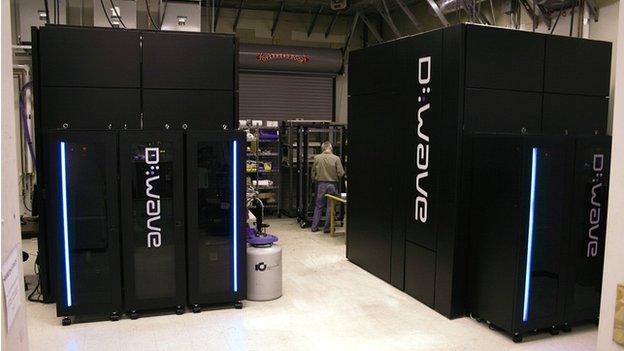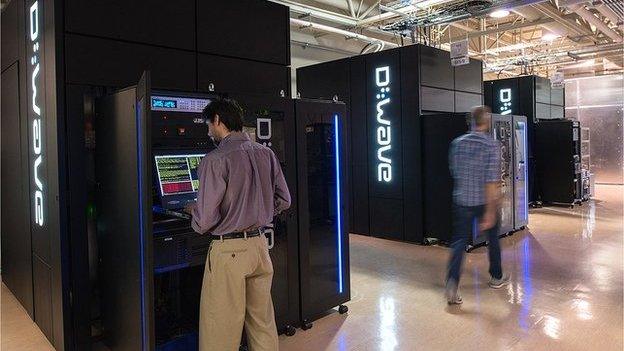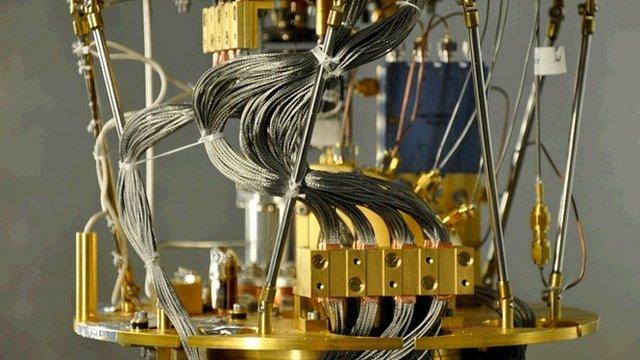Quantum phenomenon shown in $15m D-Wave computer
- Published

D-Wave released its first commercial quantum computer in 2011, and is set to release a more powerful chip later this year
Scientists says they have obtained the best evidence yet for an important quantum physics phenomenon inside a $15m computer built by a Canadian firm.
D-Wave claims it has built the first practical quantum computer, a type of machine that could solve complex problems faster than is possible today.
Scientists say they have shown that an effect called "entanglement" is present in eight units of quantum information.
Entanglement is a key step towards building a practical platform.
The results have just been published in the peer-reviewed journal Physical Review X, external.
D-Wave, based in Burnaby, outside Vancouver, has courted controversy with its claim to have built a practical quantum computer, a feat that was thought to be decades away.
In a tangle
Quantum computing exploits the strange physics of quantum mechanics, which takes hold at tiny (atomic or sub-atomic) scales.
The basic units of information in classical computers are called "bits" and are stored as a string of 1s and 0s, but their equivalents in a quantum system - qubits - can be both 1s and 0s at the same time.
But the qubits need to be synchronised using a quantum effect known as entanglement, which Albert Einstein dubbed "spooky action at a distance".
"This is the first peer-reviewed scientific paper that proves entanglement in D-Wave processors," Dr Colin Williams, director of business development at D-Wave, told BBC News.
"What's even more remarkable is that this is the largest demonstration of entanglement in any quantum, superconducting computing scheme so far," he said. "It's a big achievement for the field."
They also showed that the entanglement was stable, persisting throughout a critical operation of the processor.
The vast majority of academic research into this area of computing is based around the model of "quantum gates". These are the quantum equivalents of the logic gates that form the building blocks of circuits in classical computing.
But D-Wave has taken a different approach known as quantum annealing. On a particular type of mathematical challenge known as an optimisation problem, annealing can, in theory, short-cut classical computers to the best answer.
Working together
The authors of the latest study used one of the qubits as a "probe" to provide information on the other qubits in D-Wave's processor. Using this information, they were able to calculate how much entanglement there was in the system.
Dr Federico Spedalieri of University of Southern California's Viterbi Information Sciences Institute and co-author of the paper, said: "There's no way around it. Only quantum systems can be entangled. This test provides the experimental proof that we've been looking for."
Prof Alan Woodward, from the University of Surrey, told BBC News: "One of the three quantum effects that you need for it to be defined as a true quantum computer is entanglement."
Calling the result "a big deal", he added: "It does appear to be conclusive that they have a large number of qubits entangled and they do see to be working together."
D-Wave's processor uses 512 qubits, but the technique in the latest study was able to characterise only eight qubits.
Sceptics about D-Wave computers such as Prof Scott Aaronson of the Massachusetts Institute of Technology (MIT) say the machines show "pretty good" evidence for entanglement at a local level, but not necessarily on a large scale.
But in response, Dr Williams said there was reason to believe entanglement is pervasive across the processor.
"We could have chosen any part of the processor to do this experiment on," he explains, adding: "There's no reason to believe the entanglement is limited to just these eight qubits.
"We've done other experiments to determine entanglement in different unit cells and we see similar results."
Prof Woodward commented: "In quantum physics, one of the really difficult things is to witness something because as soon as you witness something, you interfere with it.
"By being a witness, you have to be careful you don't become part of what you're seeing. But the techniques they've used are generally accepted as showing what they are able to show: entanglement among a fairly large number of stable qubits."
However, sceptics doubt that the machines are leveraging quantum physics for any performance boost relative to classical machines.
While entanglement is required to get quantum "speed-up", they argue that it is perfectly possible to have entanglement without speed-up.
In one study released in 2013, Catherine McGeoch of Amherst College in Massachusetts, a consultant for D-Wave, found the machine was 3,600 times faster on some tests than a desktop computer.
But a study published earlier this earlier year by Matthias Troyer from ETH Zurich in Switzerland and colleagues pitted the D-Wave machine against a standard high-spec desktop computer.
On some tests chosen by the team, D-Wave's machine was found to offer no performance boost over the regular computer.
However, D-Wave maintains that the tests used by Prof Troyer's team were not ones where the company's computer offers any advantage. Indeed, Dr Williams even argues that the random challenges were too easy for the computer, which was designed to tackle a very difficult and specialised class of problems.
Dr Williams said the stability of entanglement revealed in the latest study further underlined that quantum annealing was more robust than the gate model of quantum computing.
Lab devices based on the gate model suffer from dropout, where the qubits lose their ambiguity and become straightforward 1s and 0s. This has in part ensured that quantum computers remain confined to the lab.
Quantum annealing is not as susceptible to this dropout problem, but advocates of the gate model argue that D-Wave's approach can't provide the performance boost theoretically possible with gates.
- Published20 May 2014

- Published17 January 2014

- Published16 May 2013
